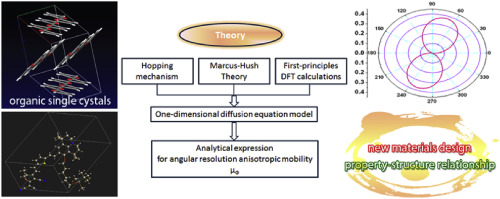Organic Electronics ( IF 2.7 ) Pub Date : 2017-12-04 , DOI: 10.1016/j.orgel.2017.11.034 Tianshu Chu , Yuan Liu

|
Charge carrier mobility is important for organic semiconductor materials and mainly determines their device performance. Thereby how to improve carrier mobility lies at the heart of the development of organic electronics. Theoretical predictions and simulations can provide guidelines towards the possible realization of high mobility and the design of highly functional semiconductor materials and thus can help to achieve further discoveries in the field. In this paper, we review a recently proposed theoretical method (an effective one-dimensional diffusion equation model) which presents the first analytical expression for angular resolution anisotropic mobility of organic single crystal semiconductors. The method encompasses the hopping mechanism, Marcus-Hush theory and first-principles calculations and is suitable to characterizing the anisotropic transport behaviors in organic single crystal semiconductors as well as to studying the property-structure relationship in semiconductor materials. Illustration of applications of the method demonstrated its capabilities in description and understanding of the transport of charges, correct prediction of angular resolution anisotropic mobility, and assist in the design of n-type and p-type organic electronic materials.
中文翻译:

模拟有机单晶半导体中各向异性电荷载流子迁移率的理论方法
电荷载流子迁移率对有机半导体材料很重要,并且主要决定其器件性能。因此,如何提高载流子迁移率是有机电子学发展的核心。理论预测和模拟可以为实现高迁移率和设计高功能半导体材料提供指导,从而有助于在该领域实现进一步的发现。在本文中,我们回顾了最近提出的理论方法(有效的一维扩散方程模型),该方法提出了有机单晶半导体的角分辨率各向异性迁移率的第一个解析表达式。该方法包含跳变机制,Marcus-Hush理论和第一性原理计算适用于表征有机单晶半导体中的各向异性传输行为以及研究半导体材料中的性质-结构关系。该方法的应用举例说明了它在描述和理解电荷传输,正确预测角分辨率各向异性迁移率以及协助设计n型和p型有机电子材料方面的能力。











































 京公网安备 11010802027423号
京公网安备 11010802027423号